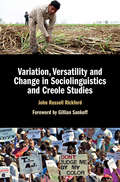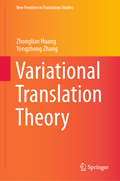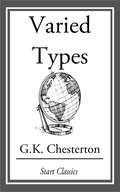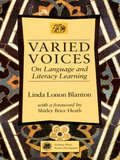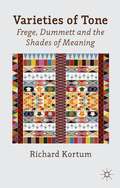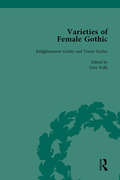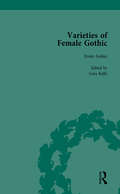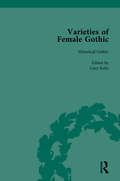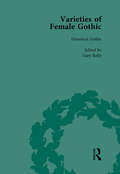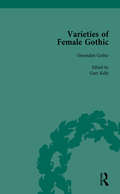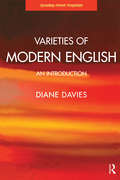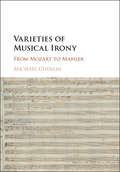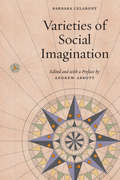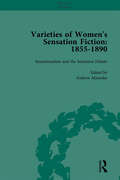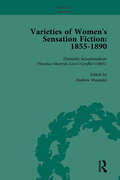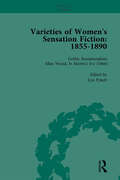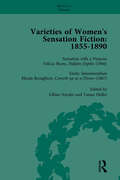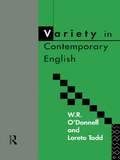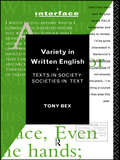- Table View
- List View
Variation in the Input
by Kristine Bentzen Marit Westergaard Merete AnderssenThe topic of variation in language has received considerable attention in the field of general linguistics in recent years. This includes research on linguistic micro-variation that is dependent on fine distinctions in syntax and information structure. However, relatively little work has been done on how this variation is acquired. This book focuses on how different types of variation are expressed in the input and how this is acquired by young children. The collection of papers includes studies of the acquisition of variation in a number of different languages, including English, German, Greek, Italian, Korean, Norwegian, Swiss German, Ukrainian, and American Sign Language. Different kinds of linguistic variation are considered, ranging from pure word order variation to optionally doubly filled COMPs and the resolution of scopal ambiguities. In addition, papers in the volume deal with the extreme case of variation found in bilingual acquisition.
Variation, Versatility and Change in Sociolinguistics and Creole Studies
by John Russell Rickford Gillian SankoffBy the award-winning former president of the Linguistic Society of America, this collection of some of John Russell Rickford's pioneering works shows how linguists in sociolinguistics and creole studies can benefit from utilizing data, theories and methods from each other, as they more frequently did in the 1960s and 1970s, when both subfields, in their modern forms at least, were getting started. The volume addresses fundamental sociolinguistic topics such as social class, style, fieldwork, speech community, sociolinguistic competence and language attitudes with data from Guyanese and other Caribbean creoles. Recurrent concepts are also considered including language versatility, variation and change, vernacular use, school success and criminal justice in African America and the Caribbean, using models, case studies and methodologies from sociolinguistics. Theoretical and applied scholars, students apprehensive about sociolinguistic fieldwork, and those considering dynamic methods like implicational scaling about which little is written in linguistics textbooks, will find this volume invaluable. Includes a Foreword by Gillian Sankoff.
Variational Translation Theory (New Frontiers in Translation Studies)
by Zhonglian Huang Yongzhong ZhangThis book, adopting the perspective of cross-cultural communication, theoretically justifies and addresses human variational translation practice for the first time in the area of translation studies, focusing on the adaptation techniques and variational translation methods, as well as general features and laws of the variational translation process. It classifies and summarizes seven main adaptation techniques and eleven translation methods applicable to all variational translation activities. These techniques and methods, quite different from those used in complete translation or full translation, are systematically studied together with examples, allowing readers to not only understand their interrelations and differences within the context of variational translation methods, but also to master them in order to improve their translation efficacy and efficiency. Readers will gain a better understanding of how variational translation is produced, and of its important role in advancing cross-cultural communication and in reconstructing human knowledge and culture. This book is intended for translation scholars, translation practitioners, students, and others whose work involves the theory and practice of translation and who want to enhance their translation proficiency in cross-cultural communication for the Information Age.
Variationist Sociolinguistics: Change, Observation, Interpretation (Language in Society #39)
by Sali A. TagliamonteVariationist Sociolinguistics: Change, Observation, Interpretation presents a comprehensive, intermediate level examination of Language Variation and Change, the branch of sociolinguistics concerned with linguistic variation in spoken and written language. Represents the most up-to-date coverage of the history, developments, and methodologies of variationist sociolinguistics Addresses all aspects of linguistic variation, including areas not usually covered in introductory texts, e.g. the phonological, morpho-syntactic, discourse/pragmatic Outlines comparative sociolinguistic approach, data collection, methodological issues; and addresses state-of-the-art contemporary quantitative methods and statistical practice Features cutting-edge research at an appropriate level to facilitate student learning Engages students throughout with a variety of pedagogical features, including Mini Quizzes to test comprehension, extensive Exercises at the end of each chapter, the opportunity to do hands-on quantitative analysis of a never-before published data set, and Notes and Tips that offer insight into conducting sociolinguistic research. Extra materials and answers to the exercises are available at www.wiley.com/go/tagliamonte
Varied Types
by G. K. ChestertonThese essays, with some alterations & additions, are reprinted from the Daily News & the Speaker. The 1st 12 were published in London, by A.L. Humphreys, 1903, as Twelve Types. Charlie Bronte William Morris & his school The optimism of Byron Pope & the art of satire Francis Rostand Charles II Stevenson Thomas Carlyle Tolstoy & the cult of simpliccity The position of Sir Walter Scott Bret Harte Alfred the great Maeterlinck Ruskin Queen Victoria The German emperor Tennyson Elizabeth Barrett Browning
Varied Voices: On Language and Literacy Learning
by Linda Lonon Blanton"I can say with certainty that this book will add a compelling sense of depth and texture to the existing body of research in first and second language literacy." --Patricia Richard-Amato, California State University at Los Angeles Varied Voices is an ethnographic study of language and literacy learning in a culturally and linguistically diverse Moroccan school. There, children and teachers turn classrooms into social spaces as they work to build learning communities. Suitable for MATESOL courses and in-service training, Varied Voices is a must-read for all instructors working with language minority students at the elementary and secondary school levels.
Variedades de la lengua española
by Francisco Moreno-FernándezVariedades de la lengua española ofrece un panorama general de la variación dialectal y sociolingüística en el espacio hispanohablante, presentado por uno de los más prestigiosos expertos en la materia. La lectura de este manual permitirá familiarizarse con los rasgos que distinguen las diferentes variedades geográficas del español, con una comprensión adicional de las causas históricas y políticas de sus diferencias y de sus implicaciones sociales. Cada capítulo incluye sugerencias de lecturas complementarias y propone temas de debate e investigación, así como un glosario que explica la terminología algo más especializada. Complementariamente, el texto remite a materiales audiovisuales disponibles en la red que permiten una aproximación más directa a las variedades del español. Estas páginas son de interés tanto para los hispanohablantes nativos como para los no nativos interesados por la diversidad dialectal. Asimismo, esta obra puede servir como texto primario, de apoyo o complementario para los estudiantes, el profesorado y los hispanistas interesados por el conocimiento de las variedades geográficas y sociales de la lengua española.
Varieties Of Tone
by Richard D. KortumIn clear and lively prose that avoids jargon, the author carefully and systematically examines the many kinds of subtly nuanced words or word-pairs of everyday discourse such as 'and'-'but', 'before'-'ere', 'Chinese'-'Chink', and 'sweat'-'perspiration', that have proven resistant to truth-conditional explanations of meaning.
Varieties of English
by Peter SiemundEnglish is a highly diversified language that appears in a multitude of different varieties across the globe. These varieties may differ extensively in their structural properties. This coursebook is an introduction to the fascinating range of regional and social varieties encountered around the world. Comparing grammatical phenomena, the book analyses the varieties in depth, identifying patterns and limits of variation, and providing clear explanations. Using comparisons with other languages, the book identifies universal as well as language-specific aspects of variation in English. This book is specially designed to meet the needs of students, each chapter contains useful exercises targeted at three different ability levels and succinct summaries and practical lists of key words help students to review and identify important facts.
Varieties of Female Gothic Vol 1
by Gary KellyThis text offers scholarly and critical editions of significant novels of Gothic fiction from the Romantic period. It illustrates the various forms of female Gothic literature as a vehicle for representing the modern forms of subjectivity, or complex and authentic inward experience and identity.
Varieties of Female Gothic Vol 3
by Gary KellyThis text offers scholarly and critical editions of significant novels of Gothic fiction from the Romantic period. It illustrates the various forms of female Gothic literature as a vehicle for representing the modern forms of subjectivity, or complex and authentic inward experience and identity.
Varieties of Female Gothic Vol 4
by Gary KellyThis text offers scholarly and critical editions of significant novels of Gothic fiction from the Romantic period. It illustrates the various forms of female Gothic literature as a vehicle for representing the modern forms of subjectivity, or complex and authentic inward experience and identity.
Varieties of Female Gothic Vol 5
by Gary KellyThis text offers scholarly and critical editions of significant novels of Gothic fiction from the Romantic period. It illustrates the various forms of female Gothic literature as a vehicle for representing the modern forms of subjectivity, or complex and authentic inward experience and identity.
Varieties of Female Gothic Vol 6
by Gary KellyThis text offers scholarly and critical editions of significant novels of Gothic fiction from the Romantic period. It illustrates the various forms of female Gothic literature as a vehicle for representing the modern forms of subjectivity, or complex and authentic inward experience and identity.
Varieties of Modern English: An Introduction (Learning about Language)
by Diane DaviesThe 'story' of English is continually re-told and re-written, as more and more people use the language and have a part in shaping the way it develops. Varieties of Modern English provides a critical introduction to the study of regional, social, gendered, context- and medium-related varieties of the language, and explores some of the debates concerning the role and impact of English in different parts of the world today. Beginning by outlining the main types of variation in language, the book focuses on the link between language or dialect and the construction of both group and individual identities. Issues of identity are crucial to chapters on the roots of Modern English, on gender and English, on ethnicity and English and on English as an international language. As well as looking at a range of 'users' of the language, Davies also explores many of its 'uses' and modes, including the English of literary texts, advertising, newspaper reporting and commentary, political speeches, email and text messaging. Written in a discursive, student-friendly style, the book also provides: * A rich mix of illustrative material * End-of-chapter Activities and related Comments at the end of the book * Suggestions for further reading Varieties of Modern English provides a thought-provoking overview of its subject and will be invaluable reading for students of English Language and Linguistics.
Varieties of Musical Irony: From Mozart to Mahler
by Michael CherlinIrony, one of the most basic, pervasive, and variegated of rhetorical tropes, is as fundamental to musical thought as it is to poetry, prose, and spoken language. In this wide-ranging study of musical irony, Michael Cherlin draws upon the rich history of irony as developed by rhetoricians, philosophers, literary scholars, poets, and novelists. With occasional reflections on film music and other contemporary works, the principal focus of the book is classical music, both instrumental and vocal, ranging from Mozart to Mahler. The result is a surprising array of approaches toward the making and interpretation of irony in music. Including nearly ninety musical examples, the book is clearly structured and engagingly written. This interdisciplinary volume will appeal to those interested in the relationship between music and literature as well as to scholars of musical composition, technique, and style.
Varieties of Social Imagination
by Andrew Abbott Barbara CelarentIn July 2009, the American Journal of Sociology (AJS) began publishing book reviews by an individual writing as Barbara Celarent, professor of particularity at the University of Atlantis. Mysterious in origin, Celarent’s essays taken together provide a broad introduction to social thinking. Through the close reading of important texts, Celarent’s short, informative, and analytic essays engaged with long traditions of social thought across the globe—from India, Brazil, and China to South Africa, Turkey, and Peru. . . and occasionally the United States and Europe. Sociologist and AJS editor Andrew Abbott edited the Celarent essays, and in Varieties of Social Imagination, he brings the work together for the first time. Previously available only in the journal, the thirty-six meditations found here allow readers not only to engage more deeply with a diversity of thinkers from the past, but to imagine more fully a sociology—and a broader social science—for the future.
Varieties of Women's Sensation Fiction, 1855-1890 Vol 1
by Graham Law Andrew Maunder Mark Knight Tamar Heller Sally MitchellFive 'sensation' novels are here presented complete and fully reset, along with scholarly annotation, a bibliography of 'sensation' fiction and articles contributing to contemporary debate.
Varieties of Women's Sensation Fiction, 1855-1890 Vol 2
by Graham Law Andrew Maunder Mark Knight Tamar Heller Sally MitchellFive 'sensation' novels are here presented complete and fully reset, along with scholarly annotation, a bibliography of 'sensation' fiction and articles contributing to contemporary debate.
Varieties of Women's Sensation Fiction, 1855-1890 Vol 3
by Graham Law Andrew Maunder Mark Knight Tamar Heller Sally MitchellFive 'sensation' novels are here presented complete and fully reset, along with scholarly annotation, a bibliography of 'sensation' fiction and articles contributing to contemporary debate.
Varieties of Women's Sensation Fiction, 1855-1890 Vol 4
by Graham Law Andrew Maunder Mark Knight Tamar Heller Sally MitchellFive 'sensation' novels are here presented complete and fully reset, along with scholarly annotation, a bibliography of 'sensation' fiction and articles contributing to contemporary debate.
Varieties of Women's Sensation Fiction, 1855-1890 Vol 5
by Graham Law Andrew Maunder Mark Knight Tamar Heller Sally MitchellFive 'sensation' novels are here presented complete and fully reset, along with scholarly annotation, a bibliography of 'sensation' fiction and articles contributing to contemporary debate.
Varieties of Women's Sensation Fiction, 1855-1890 Vol 6
by Graham Law Andrew Maunder Mark Knight Tamar Heller Sally MitchellFive 'sensation' novels are here presented complete and fully reset, along with scholarly annotation, a bibliography of 'sensation' fiction and articles contributing to contemporary debate.
Variety in Contemporary English
by W.R. O'Donnell LORETO ToddFirst Published in 1992. Routledge is an imprint of Taylor & Francis, an informa company.
Variety in Written English: Texts in Society/Societies in Text (Interface)
by Tony BexCombining insight from a variety of linguistic perspectives including Hallidayan functional linguistics and relevance theory, Tony Bex demonstrates how written texts operate within society to convey meaning. This book:- * looks at a wide variety of written genres - advertisments, letters, poetry and literature * provides an accessible and comprehensive survey of genre theory * proposes a challenging new way of analysing genre which emphasises communicative function * unusually, considers the relevance of linguistic theories of genre to the study of literary texts. * includes numerous exercises and annotated bibliographies Variety in Written Discourse will be of interest to all students of language and communication. In addition, it will be an invaluable text for those interested in literature, as well as English for Specific Purposes.

